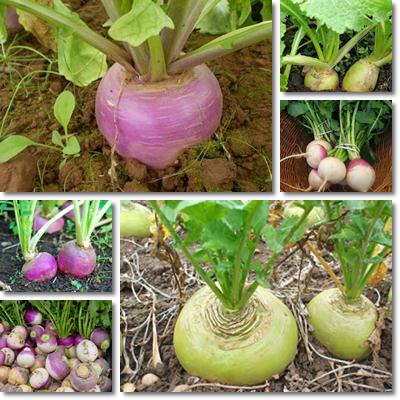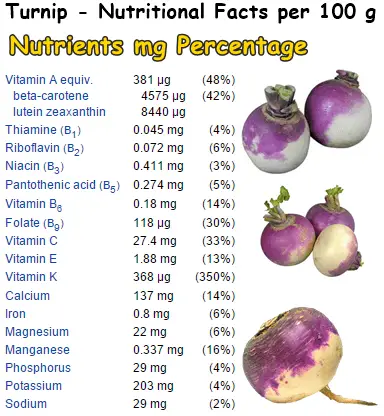The white turnip, or simply turnip, is a round root vegetable similar in taste to radishes. Turnips are a good source of carbohydrates, copper, B vitamins and vitamin C, having a slightly pungent taste. They are related to cabbage, broccoli, mustard and Brussels sprouts and are very popular in salads or baked as home-made crisps. If possible, the root vegetable should be consumed raw or cooked as little as possible to ensure a maximum intake of nutrients and enjoy the health benefits it provides.
Eating turnips not only contributes to good energy levels and improves digestion, but also helps reduce inflammation and offers antibacterial protection. Turnip leaves, also known as turnip greens or turnip tops, are rich in vitamins A and K and promote eye health and strong bones. Their good vitamin K content contributes to cardiovascular benefits, helping prevent atherosclerosis and inflammation by lowering levels of an inflammatory cytokine called interleukin-6. Because they are low in calories (only 28 kcal/100 g), turnips make a great weight loss food.

What does a turnip look like?
The term turnip generally refers to the white, round-oval principal root of the turnip plant (Brassica rapa). Turnips grow well in temperate regions and are usually planted and harvested in colder spring or fall months due to the vegetable’s lack of tolerance to warm weather. While most of the root is white both on the inside and on the outside, if a turnip is not harvested prematurely, it grows until its upper part comes above-ground. The part exposed to sunlight turns a pale purple, yellow, orange or light green, while the underground root remains white.
When harvested prematurely, turnips are considerably more tender and more palatable (sweet) and thus preferred in salads to be eaten raw. If left to mature, the vegetable can grow up to 1 kg and develop a harder, even woody flesh. Both the turnip root and its leaves are edible. The root can be cooked as any root vegetable, while the leaves like leafy greens.
See benefits of turnip greens.
Turnip recipe ideas
Turnip root goes well in salads with other greens or root vegetables (spicy radishes, grated carrots, slices of beetroot) or as a side dish by itself or in combination with other leafy greens (beet greens, mustard greens, spinach). It can be cut in cubes and baked, boiled or roasted, added to soups or stews or cut into thinner slices, seasoned and baked or roasted to make a healthier version of crisps. Turnip leaves, turnip tops or turnip greens make a wonderful side dish, perfect for anyone who loves greens. However, they may be a bit too bitter so it’s best to bring them to a boil, then change the water in order to take away some of the bitterness. Both turnip root and turnip greens are nutritious and highly versatile vegetables.

What are the benefits of Turnip?
Turnips are low in calories: they contain about 28 kcal/100 g of root. This makes them ideal if you are looking to either lose a few kilograms or maintain a steady weight. The secret to a healthy weight loss diet isn’t to starve yourself, but to eat wisely. Choose nutrient-dense vegetables, fruits, nuts, seeds and cereals and limit intake of animal products so your body gets a maximum of vitamins, minerals, antioxidants and dietary fiber in the right proportions, not empty calories from processed food.
Clean and balanced eating helps your body pack on nutrients to help it keep on working optimally and enough calories to keep it going until a next meal, without an excess that it has to turn into fats deposits. Turnips, for example, are a great choice for weight loss because of their good B vitamins and dietary minerals content as well as low calorie content.
In addition to this, the root vegetable provides significant amounts of vitamin C: 35% of the recommended daily intake for an average adult, RDI. This means that regular consumption can help reduce inflammation levels in the body responsible for cell damage and disease. Moreover, vitamin C increases resistance to bacterial infections by strengthening the immune system and provides antioxidant protection to cells and DNA. Also, the nutrient stimulates the production of collagen, a protein which, among other things, maintains the youthful appearance of our skin.

Collagen basically prevents our skin from becoming saggy by preserving its elasticity. This, in turn, contributes to a better aspect and a more youthful appearance. Lastly, vitamin C helps maintain the integrity of blood vessels, skin and bones, of which collagen is an important structure element. Eating vitamin C-rich foods such as red, green and yellow bell peppers, strawberries, guava, papaya, sea buckthorn, rose hip, kale, Brussels sprouts or even turnips is the best way to keep looking young and fresh-faced as well as enjoy good health.
Turnip roots supply the body with small amounts of several essential nutrients, notably vitamins B1, B2, B3, B5, B6 and B9, contributing to increased energy levels. B vitamins also benefit digestion and nervous system health and are vital nutrients for both children and adults of all ages.
Turnips contain copper, a mineral which prevents premature aging in the form of gray hair and discolored eyes (iris). Another important function of copper is that of protecting cells and DNA from free radical damage as a result of its antioxidant properties.
Manganese boasts a similarly impressive antioxidant function and, together with vitamin C, ensures cell repair and prevents cell damage due to free radical action. Although found in small amounts (5%), potassium contributes to healthy blood pressure levels by regulating levels of fluid in the body and mediates nerve cell-muscle communication. Also see the difference between turnip and rutabaga.
Conclusion
Turnips are a healthy vegetable with multiple health benefits. Its most notable properties include its antioxidant and anti-inflammatory action and positive effects on nervous system, digestive and cardiovascular system health. I prefer my turnip roots sliced, sauteed and served with a drizzle of olive oil, but I don’t discard the greens either. The greens make a great as a side dish to any meat or rice dish and give a pleasant bitter flavor to more satiating salad recipes.
